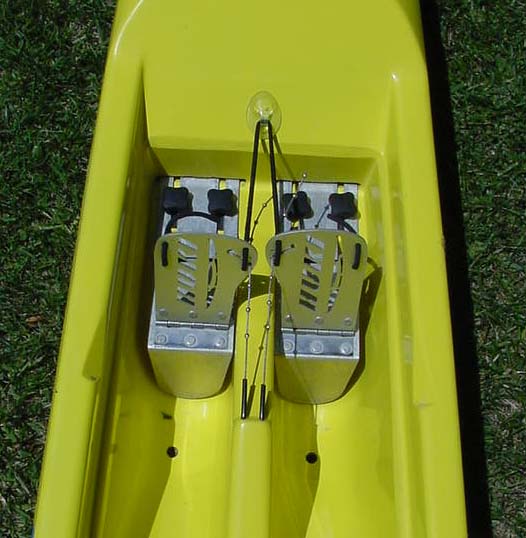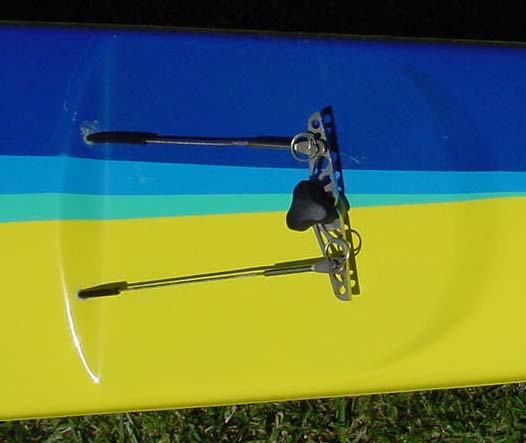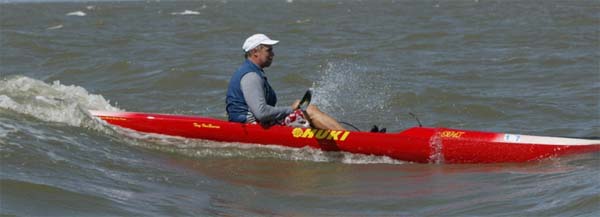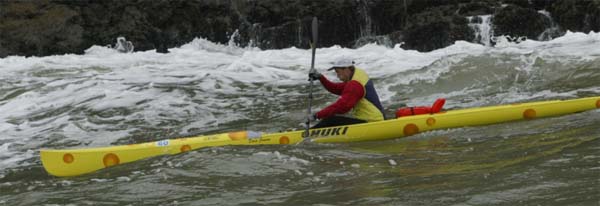Review: Huki S1-X
I'll start out my review of the Huki S1-X with my perspective of the recent past regarding surfskis here in Northern California. I think this will provide some good background info for the popularity of the S1-X here on the mainland US.
There were quite a few models and manufactures of surfskis used by both the top and middle of the pack racers Northern California racers back in the mid 1990's. It was a mixture of Australian skis (Haydens and Burons), Hawaiian skis (Twogoods, Robellos, C-Skis), and California skis (Futuras and Valhallas). The sit inside Necky Phantom was also popular in ocean and San Francisco Bay races.
Then, in 1999 I think, the Twogood Mako started showing up. This long and slender ski was unlike all of the others. It soon became the consensus that amongst many paddlers that this ski was faster upwind, downwind and in the flats than all the other skis. For a year or two everyone was buying a Twogood Mako. A year or two later, the similar Fenn Mako Millennium imported from South Africa became readily available, and everyone was buying one of those. [Editor's note: the "Twogood Mako" was a copy of the Fenn Mako built with Keith Fenn's permission by Bob Twogood in Hawaii.]
The Makos (both the Twogood Mako and the Fenn Mako Millennium) worked well for the top paddlers with good balance, but not so well for everyone else...especially in rough conditions. The Makos had the potential to go fast, but many couldn't utilize this potential speed and they struggled to paddle effectively and stay upright. If one did tip over, the Makos, with less beam and a tall deck, were much more difficult to remount than the other skis.
At that time a paddler had to choose between fast and tippy, or less fast and stable. I figured this would always be the case...that this was just an extension of the laws of physics. I figured that whatever a surfski designer could do to make a ski more stable would also make it slower. And that whatever a surfski designer could do to make a ski faster would also make it more tippy.
Then, in the fall of 2003, the Huki S1-X came out and it quickly became a very popular ski here in Northern California. It wasn't any faster than the crop of other 21 foot by 17 inch skis at that time, but it was way more stable. Many new ski paddlers (as well as some veterans) needed that increased stability. Even for those that didn't need the extra stability, why not take it if you can get it without giving up any speed?
About Huki
Jude Turczynski started Huki in Sacramento, California in 1997. Huki's initial product was an OC6 ama (the outrigger on a six person outrigger canoe). A year later, Huki came out with its first one-man outrigger canoe (OC1). Then came a second model of OC1, then an OC2, and on and on. Huki's initial surf ski was the S1-A, which was designed by John Dixon (co-designer of the Epic V10). All other Huki designs were developed by Jerry Montgomery and Jude. Jerry has a long history in design/building/racing sailboats and various types of canoes. In recent years, Jerry has been using computers to help design the hull shapes, starting with the S1-X and continuing with all ski and outrigger canoe designs since then.
Basic Dimensions and Other Info
With a paddler in it, most all of the S1-X's 21 foot overall length is in the water. Viewed from above, there's a continuous taper from the bow to the widest spot (17 inches) at the back of the seat. It's only 14 inches wide at the pedals. The hull cross sections have a smooth continuous curve without any hard chines, but the bottom is not nearly as round as the Millennium.

For a larger version of this image, click here.
The deck has smooth rounded lines without any hard changes in angles. The exception would be the deck to hull transition area just above seam and from the foot paddles on back. The drain plug and vent tube is at the high spot of the deck just in front of the pedals. There's two footwells with a venturi drain for each. The S1-X can be ordered with rudder cables that attached to the inside edge of the pedals and go down into the footwell divider, or it can be ordered with cables that attach the outside edge of the pedals and route into the hull near the edge of the boat.

Most S1-X's are fixed leg length skis, but there's also an option for an adjustable length footboard/pedal assembly. The left and right side adjust independently. The movable pieces are made from aluminum and attach and lock in position by tightening two threaded knobs per side. I've found that you need to screw down the locking knobs real tight to keep the footboards and pedals from slipping. The cables have a series of stops on them that slide into an engaging slot on the pedal and then are held in pace with shock cord. As is, I don't find the shape of adjustable footboard/pedal very comfortable in bare feet. For this reason, I'll be wearing some lightweight paddling shoes when I race an adjustable pedal S1-X in the Molokai solo race next weekend. Also, like other skis with adjustable pedals, there's extra empty volume in the footwells that is prone to filling up with water and making the ski feel heavy.

The build quality on Huki products is top notch. Regardless of the layup type, the hulls are stiff without any squishy spots. Many Hukis look like a work of art, as most buyers seem to take advantage of the multi-color options.
On the lightest layups, I've found that the exterior can be dented with hard impacts. I think the foam core is getting squished. My 2+ year old S1-X has a handful of small dents near the center of the boat...perhaps from slamming my paddle shaft against the hull while attempting remounts after a wipeouts in rough conditions. Huki offers more durable layups with only a modest weight gain.
As one would expect, all the rudder hardware is non-rusting stainless steel. The rudder cables can attached to the cross yoke at two sets of locations...offering an adjustable response rudder. A threaded knob and lock washer affix the cross yoke to the rudder shaft. One can switch from one rudder to another in less than 30 seconds. I sometimes bring a couple different rudders to races and wait and see what the condition are before deciding which to use.

Performance on the Water
I find the S1-X to be a good all-around surfski for all conditions. As mentioned above, it's both fast and stable. (I found the surfskis prior to the modern 21 foot by 17 inch skis to be good surfers, but dogs in the flats and would pound into the waves going upwind.) I probably do 20-30 point to point downwind paddles each summer when our Northern California winds are blowing, and my S1-X really takes off in the waves.
The extra stability of the S1-X allows many intermediate level paddlers to paddle a fast ski, and the top paddlers can use it too without giving up any speed.
Deck Height
The fore deck of the S1-X is lower than most other skis. This could be good or bad depending on one's perspective. The S1-X is definitely more prone to pearling than the high deck skis. On occasion I find this to be an annoyance in the steep and close together waves I see on my downwind runs in San Francisco Bay. I've paddled the S1-X in some good downwind conditions in Hawaii and along the coast here in California (going both upwind and downwind) and I find the low deck height to be less of an issue in the ocean than it is in San Francisco Bay. The ocean waves, while taller, are farther apart than what we get in the Bay. In upwind ocean conditions the S1-X seems to easily ride up and over the ocean waves rather than the wave going over the top of the ski, and I seldom have deck height issues going downwind in the ocean either.
While the S1-X fore deck is lower than most skis, it's very similar the fore deck heights of most of the Hawaiian OC1s. And the "Hurricane" OC1, one of the most popular in Hawaii, has a much lower fore deck. I suspect that the low fore deck is less of issue (perhaps is of benefit) to light paddlers, and more of an issue with heavy paddlers. Even so, my frequent training partner is around 220 pounds, and he is able to paddle his S1-X well in a variety of conditions. But would the S1-X be a better all around ski if the fore deck was higher?

Options, Options, Options
Every Huki is custom made to order. You can get exactly the ski you want...a ski fit to you with the exact options you want. There's a nearly unlimited array of combinations of colors, layups, and all the other options. Eleven standard layups, six different rudders, any color you want, fancy appearances like Hawaiian cloth inlays, hatches, weed deflectors, bungee tie downs, lock hole through footwell divider, etc. If the Huki website doesn't offer what you want, you can ask.

Summary
The Huki S1-X is a well made boat that offers both stability and speed. If you need something more stable, you probably won't find it in a 17 inch wide boat. It can go fast on the flats, upwind, downwind, and sideways.
What's to like
- Stable without being slow
- Build quality
- Aesthetics
- Custom made with many build options
- Lightweight. Layup options for a bullet proof boat at a moderate weight gain.
- Surfs very well
What's not to like
- The adjustable pedals work, but aren't comfortable in bare feet, and they slip if the knobs aren't super tight.
- The low fore deck can make for a wetter ride in certain conditions...probably more so for heavy paddlers.
For more information on Huki products, click here.

